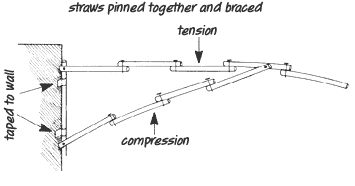|
|||||||
PAGE:
1
|
2
| 3
|
4
|
5
What It Is (continued)
As in the
Garden
Poles--Building Out
activity, aesthetics is a particularly important
criteria for these structures. Aesthetics is not just how pretty a structure
is but also how it makes the observer feel. Is the structure rigid and
strong looking? Does it have a pleasing curve to it? Is it open, light,
and airy? Does it create a feeling of tension, as if something were about
to happen any second? Does it create an image of movement? These skewer
structures may be considered sculptures and looked at in those terms.
Working on two scales offers the opportunity to discuss how the aesthetic
considerations are affected by change in scale. Does a long cantilever
which wavers and twists create a different feel than a short one? Do your
ideas of shapes that are pleasing change with size? These kinds of questions
can lead to the realm of architecture and the role that scale plays in
design.

![]()
After the session with the skewers, have the students share their results
with the whole class. Ask the same sorts of questions as in the work with
garden poles. Record their discoveries on the chalkboard or on chart paper;
students may also record drawings of structures, observations, and questions
in science logs.
The final building session is followed by weight testing, measurement, and discussion.
Often when building cantilevers, the problem of twisting to one side or the other arises. This is less pronounced on this smaller scale but should be looked for so it can be compared to the larger-scale structures.
Most of these cantilever structures will not hold much weight. In structures that are tested with weights, raising questions like the following can help the students see some of the implications of what they are doing:

